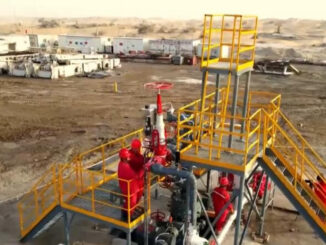
In a significant escalation of Ukraine’s drone campaign against Russian energy infrastructure, multiple refineries were targeted on August 2, 2025, leading to a record surge in domestic gasoline prices. The attacks, attributed to Ukrainian forces, struck key facilities including the Novokuibyshevsk refinery in the Samara region and the Ryazan refinery in western Russia, disrupting operations and exacerbating fuel market pressures amid ongoing geopolitical tensions.
This incident has not only driven up costs for Russian consumers but also raised concerns about broader economic ripple effects and interruptions in fuel exports.
Are you Paying High Taxes in New Jersey, New York, or California?
The Drone Attacks and Immediate Fallout
The strikes focused on Rosneft-operated refineries, with the Novokuibyshevsk facility—Russia’s 16th largest by production volume—completely halting primary oil processing after damage to its main CDU-11 unit.
Prior to the attack, the refinery was processing around 18,000 tons of crude per day, with an annual capacity of 8.3 million metric tons (approximately 160,000 barrels per day).
In 2024, it produced 1.10 million tons of motor gasoline, 1.64 million tons of diesel fuel, and 1.27 million tons of fuel oil.
Similarly, the Ryazan refinery—Russia’s third-largest—saw its capacity halved to about 48%, with two primary units (CDU-3 at 8,600 tons per day and CDU-4 at 11,400 tons per day) shut down, leaving only CDU-6 operational.
Last year, Ryazan processed 13.1 million tons of crude, yielding 2.3 million tons of gasoline, 3.4 million tons of diesel, and other products.
These attacks contributed to an immediate cut in Russia’s crude processing by around 40,000 tons per day, building on earlier disruptions that had already reduced national refining capacity by up to 10% in the first half of 2025.
As a direct result, premium Ai-95 gasoline prices on the St. Petersburg International Mercantile Exchange (SPIMEX) soared past 77,000 rubles ($946.60) per ton on August 4, marking an all-time high and an expected additional 8% rise by year’s end.
This surge reflects tightening domestic supply, with market sources linking it explicitly to the ongoing Ukrainian drone operations.
Impact on the Russian Economy
The economic ramifications extend far beyond pump prices. Russia’s oil and gas sector accounts for a substantial portion of GDP and export revenues, and these attacks are straining the war economy.
Earlier drone strikes in 2025 have already inflicted damages estimated at 60 billion rubles ($714 million), disrupting supply chains and slashing pipeline shipments by up to 40%.
The recent hits could exacerbate this, contributing to a 4% year-to-date increase in domestic fuel prices and potential fuel shortages that drive inflation.
Analysts warn of broader effects: reduced refining output limits revenue from processed products, which are more valuable than crude exports. With fossil fuel revenues down 18% year-on-year in Q2 2025—the lowest since the invasion of Ukraine—these disruptions could further pressure the ruble and force reallocations in military spending.
While the Kremlin has imposed a gasoline export ban from July 28 to August 31 to prioritize domestic needs, this measure highlights the vulnerability of an economy heavily reliant on energy exports, which fell to post-pandemic lows amid the attacks and other factors like flooding.
Timeline for Recovery
Repair timelines for damaged refineries vary based on the extent of destruction to specialized units like catalytic crackers and distillation columns. For the recent strikes, estimates suggest recovery could take one to six months, potentially extending into early 2026 for full operations.
Gasoline prices are projected to remain elevated at least until October, as interim measures like redirecting exports domestically provide limited relief.
Historical precedents from earlier 2025 attacks indicate that while some facilities resume partial output within weeks, complex repairs often drag on due to sanctions limiting access to Western parts and technology.
Damage to Exports and Affected Customer
The attacks have compounded existing pressures on Russia’s fuel exports. Seaborne diesel and gasoil shipments fell in July 2025, with overall oil product exports reaching historic lows.
Gasoline exports were drastically cut earlier in May, down significantly year-over-year, while the current ban further restricts outflows.
Petrochemical production, often co-located at refineries, faces similar disruptions, though specific data on volumes is limited. Major importers reliant on Russian supplies are feeling the pinch, as reduced output tightens global markets. Key customers include:Turkey: Accounts for 26% of Russia’s oil product exports, remaining the top buyer of diesel and gasoil.
Brazil: Holds 12% share, heavily dependent on Russian diesel imports.
China: 13% of oil products and the largest overall importer of Russian fossil fuels (over one-third of total revenues), including petrochemicals.
African Nations (e.g., Egypt, Tunisia, Libya): Saw a 45% year-over-year increase in diesel/gasoil imports to nearly 210,000 barrels per day in June 2025, making them vulnerable to shortages.
These countries may face higher prices or supply gaps, potentially turning to alternative sources like the Middle East or the U.S., which could reshape global energy trade dynamics.As Ukraine’s drone strategy continues to target Russia’s economic lifelines, the long-term implications for Moscow’s energy dominance remain uncertain. With repairs ongoing and prices at peaks, the coming months will test Russia’s resilience in sustaining both its domestic market and international commitments.
Is Oil & Gas Right for Your Portfolio?
Crude Oil, LNG, Jet Fuel price quote
ENB Top News
ENB
Energy Dashboard
ENB Podcast
ENB Substack






